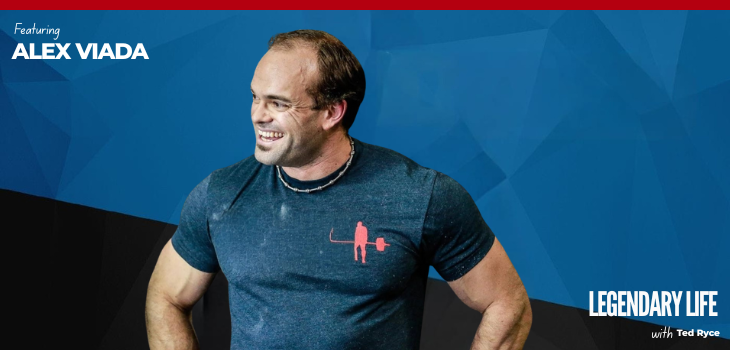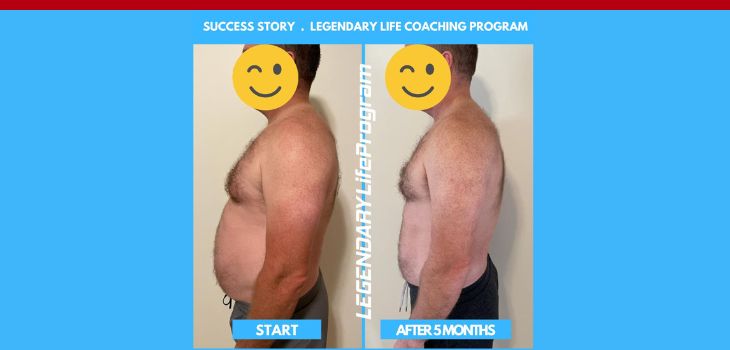If you clicked on this episode, there’s a good chance you care about your fitness. You might have a busy career or a business to run, a family to take care and limited time to take care of yourself.
If you turn forty, you might not be able to do some of those extreme and time-consuming workouts you used to do in your twenties.
You want to get in shape and build muscle, but where do you start?
Some fitness experts say you need to lift heavy weights and only work one muscle group per workout; others will say that you only need to do one set until failure. I know it can get confusing.
If you wonder what is the best way to build muscle in your 40s and 50s faster and without being in pain or spending hours at the gym, this is the right episode for you.
In this episode, Ted Ryce reveals seven training secrets that will help you get a leaner muscular body in your 40s and beyond. Listen now!
You’ll learn:
- Introduction about muscle growth over 40
- The 7 training secrets to build muscle fast in your 40s
- Secret no. #1 – Exercise form
- Secret no. #2 – Take each set to muscular fatigue
- Secret no. #3 – Rest in between sets
- Secret no. #4 – Progressive overload
- Secret no. #5 – Add sets over time
- Secret no. #6 – Stop doing the Bro split
- Secret no. #7 – Track your progress
- And much more
Links Mentioned:
Sign Up for our Free Training Series: Everything You Need To Know About Building Muscle In Your 40s
Related Episodes:
278: 5 Stranger Things To Build Muscle, Burn Fat, And Improve Sleep (That Actually Work)
245: Top 7 Muscle Building Mistakes To Avoid (And How To Bulk Up) with Ted Ryce
205: How To Build Muscle And Mobility With Gymnastic Strength Training by Christopher Sommer
Podcast Transcription: 7 Training Secrets to Build Muscle Fast in Your 40s with Ted Ryce
Ted Ryce: If you want to build muscle fast, there are a lot of things you can do. Fitness experts will say you need to lift heavy weights and only work one muscle group per workout. Magazines will tell you that you need to take special supplements, of course, right? Others say that you only need to do one set until you have failure, or use special techniques like drop sets. But what if I told you that none of those things are true? What if I told you that there's a better way to build muscle after 40, the best build muscle training? What if I told you that you can get faster results, better results than what you've been doing by focusing on just a few principles that we're going to cover today.
And what I've learned from being in the health and fitness business for 23 years now, is that most advice on how to build muscle in your 50s is misleading, at best, and completely wrong, at worst. So, if you're tired of spending hours in the gym and not seeing the results you want, I want to challenge you right now to take the information that I'm about to share with you, to use it right away, and you will see results in a week.
That's right, folks! Skeptical? Think I'm, hmm…pulling your leg or maybe doing something else to your leg? Well, look, give it a try. And we're not going to go into marketing today; we're going to go over scientific principles. Yes, less sexy, but guess what, marketing tells you what you want to hear, I'm here to tell you what you need to hear. And in case you're really serious about building muscle, I created an entire series about how to do it in your 40s, 50s, and beyond.
And what do we go over in this?
- Part One: “Why You Want to Focus on Building Lean Muscle in Your 40s, 50s, and 60s.”
- Part Two is “Six Smart Ways to Build Muscle Faster.”
- Part Three is “How Protein Helps Increase Muscle Size and Strength, and How to Figure Out How Much Protein You Should Eat to Build Serious Muscle.”
- Part Four is “How to Speed Up Muscle Recovery in Four Simple Steps.” And you can get this free training series by going to www.legendarylifepodcast.com/muscle.
What is up, folks? I haven't even introduced myself yet—just coming in strong this Monday. I'm health expert, Ted Ryce, coach to entrepreneurs, and other high-performing professionals. And we're here to talk about muscle growth today, talk about how to do this better. Because let me tell you, I've struggled with this for a long time, I've done all types of crazy workouts, I've hurt myself in the process, chasing goals, trying different things, listening to the gurus. Some of it worked, most of it didn't, and I'm here to share that wisdom with you. And let's hop into it, shall we?
Secret no. #1 - Exercise Form
Secret number one, exercise form. Before you try anything else, pay attention to your technique. And what are we talking about specifically here? What can you do? Well, number one, start slowing down your exercise speed. And I'll talk about why this is important in a second. But what I want you to do is take about two to three seconds going both ways. You don't have to do super slow. But what most people do is they move too quickly, especially folks who have an athletic background or have done some CrossFit, because CrossFit, it's all about: hey, do this many reps, and do this many rounds and try to be the time of other people in your group. So it's about doing things quickly.
And if you have an athletic background, you just feel, “Oh, if I do this more explosively, it just has more carryover." And there is some truth to that. But here's something else to keep in mind; it doesn't work as well for building muscle. In fact, the faster you go, yeah, you have this intense contraction when you explode, but it puts a lot more force on your joints when you change direction and your muscles actually don't work as hard. You're being efficient with your muscle movements. That's why you want to kick a ball fast, and you don't want to slowly kick a ball, you want to explode quickly. And so you don't need to rely on the muscles, you rely on that initial explosion, but that is the opposite of how you want to lift to build muscle.
And another thing you can do is actually focus on the muscle that you're trying to work. For example, are you working out right now while you're listening to this? Have you got me in your ears? Or are you paying attention?/ Or what are you doing? Are you doing squats right now? Are you doing bicep curls? Are you doing bench press? Do you feel the muscles working? If you're doing bench press, do you feel your triceps, your chest, your anterior deltoids? Do you feel your biceps working? Do you feel your leg muscles working?
In fact, there's some interesting research. An eight-week study had two groups of people: one group used the mind-muscle condition, in other words, focused on the muscles that you're working. And then they had another group where it's like, hey, focus on something else. And in particular, for the biceps, the people using that mind-muscle connection, really focusing on the biceps when they're working it, their biceps grew almost double in size. No, I'm sorry, let me restate that. They experienced almost double the amount of muscle growth. So their biceps didn't double in size, but for the muscle that they built, the mind-muscle folks built 50% more, okay? Or I should say, almost 100% more? I'm messing up my numbers today, forgive me. It's one of those days. So, what I'm trying to tell you here is when you do exercises, focus on the speed of the exercise, focus on feeling the muscles that you're working. These two things can help you get better results, and it's the first place you want to focus.
Secret no. #2 - Take Each Set to Muscular Fatigue
Now the second secret is take each set to muscular fatigue. It's so funny, I train my coaching clients in this, I'm like, “What's the number one thing that you need to do to build muscle?” “Um, um, add weight? Do a bench press?” No, take each set to muscular fatigue. Why is that important, though? Well, there's this idea called effective or stimulating reps. And what are they? Basically, have you ever done a set, let's say, 15 reps—say a bicep curl, and you're doing bicep curls, and you're doing everything we just talked about, you're slowing things down, you're focusing on the muscle, you feel the muscle, but eventually, maybe around rep 10 or 11, you start to slow down, start to really feel that muscle and it feels heavy, even though some weight that you can lift 15 times isn't what most people would call heavy, it starts to feel heavy.
Well, that's what we're talking about. And those reps, at the end of the set, those are the effective reps, those are the stimulating reps, those are the money reps. In fact, I had a client when... Rick—and shout out to you if you're listening, Rick—he came to me, he showed me his workout. He was doing a lot of different things, but he was doing four sets of dips of 10 reps with his bodyweight. And I was just thinking, “Man, this guy…” -..." Because Rick is a beast, right? He's a hard-charging, you know, motorcycle riding, entrepreneur, just totally kick ass guy. And he was doing sets of 10 for bodyweight. I said, “You know what, Rick? Do this, let's cut your sets in half and just see how many reps, you can do in two sets.” You know what, in the first set, he got, like in between 15 and 20. I forget the numbers exactly, but he could do a lot more than 10, is the point.
So the point here is make sure you don't have to do as many sets as you probably think—although we'll talk about sets in a bit. But what you want to do with every set is make sure that you're taking a close to failure without actually hitting failure. We're not going to talk about failure today, just understand there's no need to go there. But if it does happen occasionally, okay, but no need to go to failure, but get close to it.
Secret no. #3 - Rest in Between Sets
Secret number three, rest in between sets. Well, in this world we live in where time is precious and everybody's in a pinch, it just makes sense to not rest that long. And then so many people throughout the years I've worked with, "Oh God, come on, what do I need to do? I can't just sit here rest!" Yeah, you’ve got to sit there and rest. Why? Because it leads to better results. Better results how? More muscle, more strength, folks, okay? More is not better, and taking away your rest, just so you can push a bit more is not a solid technique, although there are some techniques that can take advantage of this, but that's not what we're going to be talking about today.
In fact, there's a study showing this. So, they took a group of 21 guys…Sorry, ladies, a lot of…we're not going to talk about why they use men more often than women. And no, it doesn't have to do with sexism, it has to do with keeping things consistent because of the menstrual cycle. So, I hope nobody got triggered with that one. So, they took a group of 21 young guys, and they assign them either to a group where they rested one minute or rested three minutes. And everything else was the same. They both did the same type of workouts, the same number of sets, etc, etc. But the only thing that was different was one minute or three minutes of rest in between sets. And guess what? Not only did the three-minute group build more strength but they build more muscle.
Now again, people don't like to take long rest because it's like, hey, what am I doing here? But it's better to take the rest and do two sets and do them in the way that you're going to get better results. That's called working smart, folks! Instead of resting once and doing it because emotionally, you just feel better resting a shorter period of time, and it feels like your workout’s harder. Yeah, but it's harder, but so is doing a 10-mile run while you're stopping every five minutes and drinking a shot of tequila, but that's just dumb to do. So don't do dumb, do smart.
And here are a couple things, because I feel you. Look, I'm not as time pinched as most people, at least these days, but I've been there, okay, I've been there. And here's some things you can do. Now, of course, you can just, if he got the time, if you got the patience, do one set at a time and rest after. Another thing you can do, you can pair exercises together. Best way to do this is to pair different muscle groups. For example, you could do a lower body exercise with an upper body. That's a really good one. Or opposing muscle groups, like back and chest or hamstrings and quads, you can do that. And you can actually do them in a superset fashion if you want, where you would say, do like a hamstring curl, and then without any rest you would jump on and do leg extensions.
And then you'd rest about 90 seconds or so after that. So you're only resting 90 seconds and you're doing two exercises and resting 90 seconds. I hope that's clear. Sometimes it's hard to describe these things. It's really easy on paper, but it’s harder to describe it. There isare some research showing that when you work opposing muscle groups like this in a superset fashion, it actually works better. Not going to dive into that, but the reason I'm sharing it here is because it can save you some time. So you don't need to sit and rest three minutes, all right? And you don't even need to rest three minutes. Sometimes I'll rest around two if I'm just doing one set at a time. But if you want to alternate, you can rest about 90 seconds or so, alternating or super setting.
Secret no. #4 - Progressive Overload
So secret number four, progressive overload. Well, what is that? There's a Greek story that really nicely illustrates this. So, there is an ancient Greek named Milo, and he had a calf. And what he would do is he would pick up the calf and carry the calf every morning. And as Milo got older, the calf also got older and bigger, they both got bigger. But Milo, because he would carry the calf every morning, by the time Milo was in his teens, or 20s, or whatever—whatever the story, I don't remember the story—he was carrying a full-grown bull. And while I don't recommend carrying bulls, I do recommend adding reps over time.
So, let's break it down like this. So let's say that you're bench pressing 135 for 12 reps, and three sets, and you've been doing that for the past year, and you're wondering why you haven't changed. Well, time to shoot for 13 reps, or 14, or 15. Every workout or every week, let's say, maybe not every workout, but every week, you want to try to push for more reps with the weight you're using. And then eventually, you want to push for more, you want to add more weight. A good time to add more weight is when you find it really hard to add reps.
Now, we could get into a whole discussion about recovery because that stops people from improving, or crappy programs also stop you from improving because you're constantly fatigued and recovering. But let's say that you're on a good program and your recovery is solid, you might run into a situation where it's really hard to add more reps, or you're up in the 20s and you just hate doing long sets. So, time to add weight then.
And then you repeat, you start getting more and more reps every week with that new weight. And then when it gets to be to a certain point, you add more weight and repeat. And you may go back to that idea like, “Well, I thought the number one thing was to work till muscular failure. And you've said before, Ted, that if you're doing three sets of 10, three sets of 20, three sets of 30, three sets of 12, three sets of 15, three sets of 6, they all kind of lead to similar amounts of muscle growth.” And that's true. But what we're saying here is that if you're three sets of 135 on the bench press for 12 reps, what if you could add reps, add weight, add reps, add weight, you know, do the process that I just delineated here for you and say like, in a year, eight months, a year or however long, you know, a period of time, you would be doing 12 reps with 205, right? That's going to be a different person. That's going to be a very different physique on that same person, is what I should say.
So I hope that is clear. And again, if you're not clear on this, you want to go to my muscle building series on how to build muscle in your 40s, 50s, and beyond, www.legendarylifepodcast.com/muscle. Again, it's a free training, so that is the place to go.
Secret no. #5 - Add Sets Over Time
Let's get back to it. Secret number five, add sets over time. Let's say you're doing everything that I've already talked about: your form is on point, your bringing each set to that muscular fatigue point, you're resting enough in between sets, you've got good program design, right? And you've been doing this progressive overload thing, you're only doing a couple sets, you're adding reps, and then you're adding a little bit of weight, and adding a little bit of reps, adding a little bit weight. How do you take things to the next level? Well, now it's time to add some sets.
Now there are folks who will say that you should only do one set to failure and do that a couple times a week, and that's all you need to do. And if your time-crunched, that's not a bad approach, but if you're talking about the best results possible, and you do have time to do more than one set, it ain't optimal. And in fact, there's a 2015 randomized control trial, in other words, a study, a well-done study published in the Journal of Strength and Conditioning Research, that showed that this study that lasted six months, with military personnel, by the way, they had three groups of people, groups performing one set, three sets, or five sets. And what they showed was the group who did more, got more muscle growth.
Now, they also had more strength gains too, but it was very meager and not worth the trouble. But as far as muscle is concerned, more sets outperformed less sets. Of course, this needs to be applied individually. Don't say, “Well, I've only been doing two sets, now I'm going to do five sets.” Yeah, your joints might not like you so much after all, so you want to be careful how you add volume, you don't want to just start adding volume. It can really take a toll on your joints. You’ve got to be mindful of the way you do this. You've got to add slowly, just like how I talked about adding reps and then adding weights. You want to do something similar to that. You want to add one set, stick with that for, I don't know, a month or so, a few weeks to a month, then you can try adding another set. And that's how you want to roll, all right?
Secret no. #6 - Stop Doing the Bro Split
And how do you do this without spending three hours in the gym? Well, another thing that you can do, and this is secret number six, is stop doing the Bro split. Are you working chest on Mondays, back on Tuesdays, legs on Wednesdays? Well, the 1980s called an “Arnold wants his workouts back”, Conan the Barbarian called, he wants his... I was trying to think of like, what are those jumpsuits called, those Terry jumpsuits? Anyway, my joke is totally bombing. Okay, I won't quit my day job, don't worry. But what I'm trying to say is do total body workouts.
Most people would do a lot better if they hit the same muscle group more frequently. And by the way, they've even showed this becomes more important as we age. So if you're doing that one body part per day, per week type of thing, get rid of that. And what do you do instead? Start doing total body workouts. If you're doing twice a week, you should be doing total body workouts. If you're doing three times a week, do total body workouts.
Now, there are some nuances here, and I'm not going to get into it, but just to throw another study your way. There was a 2018 study that compared the Bro split that I just made fun of, right? The chest on Mondays, back on Tuesdays, legs on Wednesdays, forms and abs, they start getting really weird on Thursdays, then shoulders and eyebrows on—even though eyebrows aren't muscle, but whatever—on Fridays, whatever it is, and they compare that working a body part one time week to training the body part five days a week.
Now, only with one exercise and with three sets, but they showed that it was superior, they gained a lot more muscle by doing you know, you don't have to do it five times a week, by the way, but training twice a week and maybe even more, is going to be more beneficial than doing it once.
So, doing total body workouts—just to make this super practical for you. If you're doing total body workouts three to four times a week, and that's what I recommend, three to four times a week, hit total body workouts. Quick bonus tip is if you're doing four times a week, you'll have to double up days, so do a heavier day, then a lighter day. Heavier day could be five to 12 reps and the lighter day could be 15 to 30 reps. So, if you roll like that, you're going to see a lot better results, unless you are very, very, very, very new to strength training.
There was another study that found that no difference in gains between training a muscle once a week or up to five times a week in untrained guys. So if you're a few years behind on your workouts, you've been on the couch for a while, you don't need to jump into doing five days a week, or even three days a week—hitting a muscle group five times a week, I should be more specific here. You can start by doing, you know, one time a week is okay but eventually, you're going to want to switch to the higher frequency, hitting the muscle groups more often.
But I will say this, even though they didn't gain more muscle—and again, this is in untrained men—what they did gain is they found that the group that trained three times a week had greater fat loss than the group training two times a week. So yeah, more is better. Unless for some reason, you don't want to do it or can't do it. But three times a week, folks, and I recommend four, three or four.
So again, if you're completely untrained, you don't need fancy program, you don't need to do some of the fanciness that I've recommended here, but show up, do total body workouts three to four times a week. Again, although two or five days is also an option or even six days. And take what I'm sharing with you here, experiment with what resonated with you, and then see what you like. That matters, too. It's a little bit of a bonus tip.
Secret no. #7 - Track Your Progress
Now, let's talk about the last secret here, is track your progress. People who track their results, get the best results. As the famous management guru, Peter Drucker, said, "What gets measured, gets managed.” Now, I personally use my app for tracking my workouts. But there is Simple Workout Log at www.simpleworkoutlog.com and Gymaholic, that's gymaholic.me. I don't have any affiliation with those websites, just simply sharing. I haven't used them either, but I looked them over, and those were recommended to me from people who track their workouts.
Again, I use my app because it's mine and it works, I like it, and that's what my clients used too. But the point is, whether you use the node app on your phone, which is what I used before I started using our app, or if you're, you know, download one of the other apps that I mentioned, track your workouts. If you're really looking to make an improvement, track your workouts.
All right, folks, that is the seven secrets, we'll just go over them again, briefly. So, exercise form, start to slow things down, focus on that mind-muscle connection. Secret number two, take each set to muscular fatigue. It doesn't matter if you're doing five sets of 10, if you're not reaching that fatigue point, start with one or even two or two sets or even one or three or whatever, but make sure you're taking them to muscular fatigue. Number three, rest in between sets. Now you can pair exercises together, but don't be that one minute or 30 seconds rest person. Start to find ways to pair things together or do like I do, I start tweeting in between my sets. I take a lot longer in the gym, to be honest, and sometimes rest more than three minutes. But that's what I do; works for me. But for you, make sure you rest more than a minute. You're doing one set at a time, two to three minutes, or 90 seconds to three minutes is going to be the sweet point. And listen to this episode again and re-listen to those methods I've used where the alternating sets or super sets, those can really help you save time.
Secret number four, progressive overload. If you're still doing the same exercise with the same way, with the same reps, with the same sets, and you've been doing that since 2019, well, that's why you haven't changed. So, you've got to slowly add reps over time, you've got to slowly add weight over time. And then secret number five is add sets over time—more sets to give better results. Who would have guessed, folks, that actually putting in the work—there's no way to biohack your way out of putting in the work, okay? Who would have guessed that putting in more work led to better results? But there you have it.
Secret number six, hit total body workouts. Let Arnold, Conan the Barbarian, The Terminator, have his bro splits back. Use total body workouts, they just work better. One exercise per muscle group is all you need, five to 10 exercises, go to it, folks. Secret number seven, track your progress. Now it's a bit of a bonus, but man, that is a game-changer if you learn how to do it. So track your progress.
That is it for this. The next episode on Friday is we're going to be talking about... well, I'm going to be answering listener questions. I've got some great questions that I want to share with you. And we're going to be answering listener questions on that episode. And one more time, if you want to learn more about building muscle and you want to see some things, you want to get more in-depth with this information and not just listen to it on this podcast because you feel like you missed a couple things, go to www.legendarylifepodcast.com/muscle and get my free training series, “Everything You Need to Know About Building Muscle in Your 40s and Beyond.”
That's it for me, folks, hope you enjoyed today, and speak to you on Friday!
Sign up to receive email updates
Enter your name and email address below and I'll send you periodic updates about the podcast.









